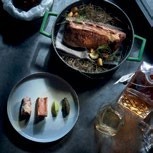Restaurants are turning to alternative pairings for diners who don’t drink.


Non-alcoholic pairings have become the latest must-have in the realm of fine dining as restaurants set out to prove they can impress even those who don’t drink. The idea is straight forward – create a nonalcoholic beverage, from a range of juices, teas, and infusions, to go with each dish of the meal. “It’s important that we are inclusive, so that people who aren’t having alcohol can still have the same level of experience as those who are doing the wine pairing,” explains Chip Steel, sommelier and beverage manager for Preludio. Singapore has always been a place with low alcohol consumption (2.9 litres per person in 2015, compared to South Korea’s 10.9 litres) – and now there are options for teetotallers.
While the concept is simple, execution is anything but. Often, mixers use wine for reference in creating a teetotaller’s approximation of the beverage, considering attributes like acidity or structure. At restaurant Cloudstreet, Chenin Blanc from Jasnieres in the Loire – full of orchard fruits, green aromas and a slight flintiness – finds its likeness in a combination of smoked apple, fennel, and sea salt.
Other times, the concoctions take their cue from the dish pairing. One of the signatures at Preludio, squash agnolotti with parmesan sauce and aged balsamic vinegar, is currently paired with a Barbaresco. Its non-alcoholic counterpart though, is an intriguing “piccolo latte” of balsamic vinegar, milk, and strawberry that mirrors flavours found in the dish.
Even for those who do drink, sober pairings offer other advantages. For one, it’s a creative and intellectual exercise, since sommeliers have every possible ingredient to play with. “Non-alcoholic pairings give us complete control, so we try to make it as interesting as possible,” shares Aaron Jacobson, general manager of restaurant Zen.
Unlike wine, which is already a finished product, making beverages in-house means that restaurants can tweak every aspect of a drink until it’s a perfect match for a dish. If anything, a non-alcoholic pairing is the truest expression of the possible synergy between the kitchen and the drinks manager since the chefs also get much more involved than they would with just wine. “I’m not culinarily trained, so I get a lot of input from the kitchen on working with certain ingredients. There’s a lot of back and forth,” explains Vinodahn Veloo, Cloudstreet’s sommelier.
AESTHETICALLYPLEASING
Getting the right look plays a large part in the nonalcoholic pairing experience. The clarity and colour of the glassware used for each beverage all add to the experience.
“[IT’S SO THAT] PEOPLE WHO AREN’T HAVING ALCOHOL CAN STILL HAVE THE SAME LEVEL OF EXPERIENCE AS THOSE WHO ARE DOING THE WINE PAIRING.”
TEMPERANCE AND TEMPTATIONS


CLOUDSTREET

You’ll find some of the most varied pairing options here. Steel’s creations range from straightforward sparkling yuzu ginger beer that’s meant to replace Champagne to an unusual but delicious combination of sour cherry juice, espresso and pop rocks.
WHAT MAKES A DRINK?
Probably the most important component in any drink pairing. Acidity helps cut through dishes that are fatty or sweet while complementing the savoury; anything on the sour end of things is also a safer bet — low acidity beverages will taste “flabby” when paired with tart foods like salad dressing or tomato sauce.
Because it’s hard to remove residual sugars from fruit juice without fermenting it, sweetness is something that is hard to avoid when we are talking about nonalcoholic pairings. Thankfully, sweetness also works well with a range of dishes, complementing desserts, while contrasting with the savoury and rich – think blue cheese with port.
While alcohol contributes to the body of the wine, the sensation of “weight” in a drink can be replicated through other means. Honey, as well as some fruit juices, can add a viscosity that makes drinks seem more flavourful and satisfying.
At Zen, each juice comes in the same glass as its corresponding wine. While this certainly helps with making teetotallers feel more included, the main reason is to help each drink express itself better. A perfumed concoction of oxidised apple juice and oolong tea steeped with tsubu-arare (Japanese rice crackers) comes in the same wide-bottomed glass they use for aromatic whites like Gewurztraminer or Chardonnay.























